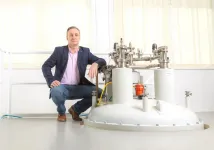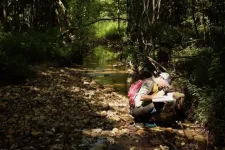(Press-News.org) Water is an ephemeral thing. It can emerge from an isolated spring, as if by magic, to birth a babbling brook. It can also course through a mighty river, seeping into the soil until all that remains downstream is a shady arroyo, the nearby trees offering the only hint of where the water has gone.
The interplay between surface water and groundwater is often overlooked by those who use this vital resource due to the difficulty of studying it. Assistant professors Scott Jasechko and Debra Perrone, of UC Santa Barbara, and their colleagues leveraged their enormous database of groundwater measurements to investigate the interaction between these related resources. Their results, published in Nature, indicate that many more rivers across the United States may be leaking water into the ground than previously realized.
In many places surface waters and groundwaters connect, while in others they're separated by impermeable rock layers. It depends on the underlying geology. But where they do intermingle, water can transition between flowing above and below ground.
"Gaining rivers" receive water from the surrounding groundwater, while "losing rivers" seep into the underlying aquifer. Scientists didn't have a good understanding of the prevalence of each of these conditions on a continental scale. Simply put, no one had previously stitched together so many measurements of groundwater, explained Jasechko, the study's co-lead author.
Gaining and losing rivers
Waterways can gain water from the surrounding aquifer or leak water into the ground depending on the conditions.
Typical groundwater studies include water level measurements from a few hundred to 1,000 wells. This study encompasses 4.2 million.
Perrone and Jasechko devoted years to compiling data from 64 agencies across the U.S. and analyzing the results. "Compiling these data was a massive undertaking. We collected millions of datapoints and reviewed hundreds of papers over the course of six years," Perrone said.
The resulting database has precipitated a number of the team's subsequent studies. "We can use this extensive dataset in innovative ways to answer questions that we have not been able to address previously," she added.
For this paper, Jasechko, Perrone and their coauthors compared water levels in wells to the surface of the nearest stream. "We apply a simple method to a large dataset," Jasechko said. "We identify wells with water levels that lie below the nearest stream, implying that these nearby streams could leak into the subsurface if it is sufficiently permeable."
The team found that nearly two-thirds of the wells had water levels below the nearest stream. This creates a gradient that can drive water from the river channel into the aquifer beneath.
"Our analysis shows that two out of three rivers in the U.S. are already losing water. It's very likely that this effect will worsen in the coming decades and some rivers may even disappear" said co-lead author Hansjörg Seybold at ETH Zurich.
"The phenomenon, set in motion decades ago, is now widespread across the U.S. There are far more streams draining into underlying aquifers than we had first assumed," Seybold continued. "Since rivers and streams are a vital water supply for agriculture and cities, the gravity of the situation came as a surprise."
A map of well water levels with respect to the surface of the nearest river.
Photo Credit: JASECHKO ET AL.
Rivers were particularly prone to losing water in arid regions, along flat topography and in areas with extensive groundwater pumping, they observed. A prime example of this would be flat agricultural land in semi-arid regions like California's Central Valley. "We are literally sucking the rivers dry," Seybold said.
Losing rivers can impact other water users, downstream communities and ecosystems that rely on surface flows. "Historically, we've often treated these two resources as separate resources," Perrone said. "Our work highlights the importance of considering groundwater and surface water as a single resource where they are connected."
The researchers also found that losing rivers have been widespread in the U.S. for quite some time, present in many places at least as far back as the 1940s and '50s. And while many waterways naturally lose water, the issue can be exacerbated by human activity.
Humans have extracted water from the ground for thousands of years; in America they've been doing so for hundreds of years. The practice accelerated after World War II and has been rampant since the 1970s, accompanied by the undesirable and unintended consequences it entails.
"This isn't a new phenomenon," Jasechko said. "It's been with us for decades."
Water levels do fluctuate over years and decades, and unfortunately the researchers have only one data point for many of the wells in their sample. Other work by the team suggests that groundwater typically fluctuates by no more than a few meters over the course of a year. However, the water level for the many wells near losing rivers was more than two meters below the surface of the nearest stream, increasing the researchers' confidence that leaky rivers are likely widespread.
The sun shines down on a shallow marshy stretch of river bordered by grasses and riparian shrubs. Mountains are visible off to the left against a clear blue sky.
This section of the Santa Ynez river leaks water into the surrounding aquifer.
Photo Credit: DEBRA PERRONE
"We can only observe well water levels where wells exist," Jasechko acknowledged. "It's an obvious but important point. Our analysis is inherently biased to places where wells have been drilled, and therefore also to places where groundwater is pumped."
While the researchers don't see any straightforward way around this in the short-term, they hope their results can inform resource management and monitoring, perhaps informing policies that fund more monitoring wells in under-surveyed areas.
"Big studies like this get people thinking about broader water policy," Perrone said. "And for me, that is why continental scale analyses are important."
"My hope is that this study gets more people thinking about the interconnection of groundwater and surface water where these two resources are connected, and it also gets groundwater policy on the map," she continued. For so long this resource has been literally and metaphorically out of sight.
Perrone and Jasechko plan to expand this type of large-scale analysis to other parts of the globe and see how pumping and losing rivers impact groundwater-dependent ecosystems. Perrone also intends to connect their results back to her groundwater dashboard.
"Losing rivers aren't some hypothetical scenario," Jasechko stated. "They're here and now." They are in part the result of the past century of water use and misuse.
"If we have a better understanding of how widespread this phenomenon is, then we can influence future policy in positive ways," added Perrone. Because society is past the point where it can talk about prevention; we're now talking about response.
INFORMATION:
George Washington University researchers found low dose aspirin may reduce the need for mechanical ventilation, ICU admission and in-hospital mortality in hospitalized COVID-19 patients. Final results indicating the lung protective effects of aspirin were published today in Anesthesia & Analgesia.
"As we learned about the connection between blood clots and COVID-19, we knew that aspirin - used to prevent stroke and heart attack - could be important for COVID-19 patients," Jonathan Chow, MD, assistant professor of anesthesiology and critical care medicine and director of the Critical Care Anesthesiology ...
A recent study shows that lettuce can be grown in greenhouses that filter out wavelengths of light used to generate solar power, demonstrating the feasibility of using see-through solar panels in greenhouses to generate electricity.
"We were a little surprised - there was no real reduction in plant growth or health," says Heike Sederoff, co-corresponding author of the study and a professor of plant biology at North Carolina State University. "It means the idea of integrating transparent solar cells into greenhouses can be done."
Because plants do not use all of the wavelengths of light for photosynthesis, researchers have explored the idea of creating semi-transparent organic solar ...
AUSTRALIAN - LED INTERNATIONAL RESEARCH TEAM GENERATES THE FIRST MODEL OF EARLY HUMAN EMBRYOS FROM SKIN CELLS
In a discovery that will revolutionize research into the causes of early miscarriage, infertility and the study of early human development - an international team of scientists led by Monash University in Melbourne, Australia has generated a model of a human embryo from skin cells.
The team, led by Professor Jose Polo, has successfully reprogrammed these fibroblasts or skin cells into a 3-dimensional cellular structure that is morphologically and molecularly similar to human blastocysts. Called iBlastoids, these can be used to model the biology of ...
What The Study Did: Racial and ethnic disparities in very preterm birth and preterm birth among 8,026 women were similar during the first wave of the COVID-19 pandemic in New York City compared with the same period the year prior in this observational study.
Authors: Teresa Janevic, Ph.D., M.P.H., of the Icahn School of Medicine at Mount Sinai in New York, is the corresponding author.
To access the embargoed study: Visit our For The Media website at this link https://media.jamanetwork.com/
(doi:10.1001/jamanetworkopen.2021.1816)
Editor's Note: The article includes conflict of interest and funding/support disclosures. Please see the article ...
Using artificial intelligence and mobile digital microscopy, researchers hope to create screening tools that can detect precursors to cervical cancer in women in resource-limited settings. A study led by researchers at Karolinska Institutet in Sweden now shows that AI screenings of pap smears carried out with portable scanners were comparable to analyses done by pathologists. The results are published in the journal JAMA Network Open.
"Our method enables us to more effectively discover and treat precursors to cervical cancer, especially in low-income countries, where there is a serious lack of skilled pathologists ...
BOSTON - Most surgical patients with a history of penicillin allergy can safely be given the guideline-recommended antibiotic cefazolin to prevent infection instead of several penicillin alternatives that are less effective and more expensive, according to a study conducted by Massachusetts General Hospital (MGH), the University of Colorado Anschutz Medical Campus and the University of Porto in Portugal. The researchers reported in JAMA Surgery that the frequency of allergies to both penicillins and cefazolin was so small that most patients should receive cefazolin regardless of their allergy history.
"Under current practice, ...
UPTON, NY--Electrons in a solid occupy distinct energy bands separated by gaps. Energy band gaps are an electronic "no man's land," an energy range where no electrons are allowed. Now, scientists studying a compound containing iron, tellurium, and selenium have found that an energy band gap opens at a point where two allowed energy bands intersect on the material's surface. They observed this unexpected electronic behavior when they cooled the material and probed its electronic structure with laser light. Their findings, reported in the Proceedings of the National Academy of Sciences, could have implications for future quantum information ...
March 17, 2021 - In recent years, hospital charges and Medicare payments for patients with hip fractures have increased much more rapidly than charges and payments for orthopaedic surgeons, reports a study in the Journal of Orthopaedic Trauma. The journal is published in the Lippincott portfolio by Wolters Kluwer.
The gap in Medicare reimbursements to hospitals compared to surgeons widened substantially in the last decade - even as patient outcomes improved and healthcare resource use decreased, according to a new analysis by Brian Werner, MD, and colleagues of UVA Health, Charlottesville, Va. "The results confirm our hypothesis that hospital charges and payments contribute significantly more to the increasing cost of treating a hip fracture patient than surgeon ...
He and his research group have found a way to more precisely determine the properties of these materials, because they can better account for the underlying disorder. Their article has been designated "ACS Editors' Choice" by the editors of the American Chemical Society journals, who recognise the "importance to the global scientific community" of the Leipzig researchers' work and see it as a breakthrough in the accurate description of phase transition phenomena in disordered porous materials.
In mesoporous materials, the pore openings are far smaller than in a normal sponge: their diameters range from 2 to 50 nanometres and are invisible to the naked eye. Nevertheless, they have a number of interesting properties, including with ...
The abundance and other characteristics of rocks partially extending above the water surface could be important for improving the recovery of aquatic insect populations in restored streams.
Nearly three quarters of stream insects reproduce on large rocks that sit above the water surface by crawling underneath to attach their eggs. Increasing the number of large and stable emergent rocks in streams could provide more egg-laying habitat and allow insects to quickly repopulate restored streams.
"We found that restored streams had fewer emergent rocks for egg-laying and fewer total eggs than naturally intact streams," says Samantha Jordt, first author of the paper and an M.Sc. student at NC State's Department of Applied Ecology.
The study also ...




